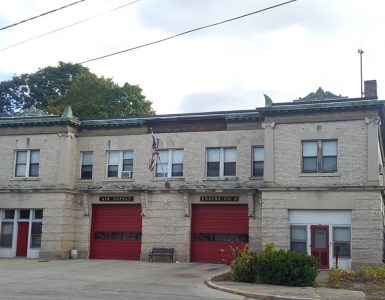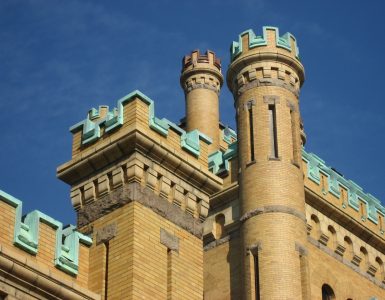Photo © Psuedo_Work from Flickr
This Old House names Providence’s Broadway-Armory District as one of the ten best places in the northeast to buy an old house.
Why Buy Now?
Along with reasonable prices, there’s help for home buyers. The Providence Revolving Fund offers loans to purchasers, and there’s also assistance available from the city and the state, which offers tax credits for certain types of restoration work.
My birthday is coming up, someone feel free to buy me an old house.






revolving fund $ is only available to houses in designated historic districts.
Good thing a portion of the armory district is in a historic district. I think the real shame of the revolving fund is that monies only apply to exterior renovations that make the house appear historically ‘correct.’
I guess I didn’t finish my thought. It is great that the funds are available but it would be greater if some of the funds were made available to historic houses in neighborhoods that haven’t yet had an historic designation. A pilot program maybe, to see if the funds spent on a house, say on Hendricks Street in Mt Pleasant could start a little historic revolution of other houses on that street replacing vinyl with clapboards or something.
It would be nice if someone had some incentive to remove some vinyl on Atwells.
I definitely agree that the funds should be available outside historic districts, or on the fringes of disticts, but the scope of the funds should also be expanded. Take siding, what of the high lifetime cost of wood clabboard maintenance? The fund’s managers could be less rigid in their view of what ‘historic’ is. For instance, they could allow a homeowners to choose a cementitious siding product that looks indistinguishable from wood but is both cheaper and easier to maintain.
Yes, thriftiness should be recognized as an historical attribute, something to preserve. Certainly if our forbears had the option of cementitious siding, they would have used it. We should be doing what we can to preserve our historic buildings, but insisting on 19th century technologies and products is short sighted. If something like cementitious siding allows our buildings to be restored to their historic looks and extends the lifetime and cost-effectiveness of that, then it should be allowed.
I mean we allow historic buildings to have indoor plumbing and electricity and parking for automobiles.
The revolving fund restricts loans to homes already in historic districts because those locally zoned historic districts are the only places where tax incentives are provided to homeowners and businesses for renovating and maintaining historic buildings. Revolving fund loans simply go further in an area where 20% of what you spend comes back to you in tax relief. Making loans outside these zones would pretty much be throwing money out the window; the system is meant to self-regulate. It only makes sense to restore the existing historic districts first. When that’s done, we zone new areas, and apply the credits and loans to those. If there are areas people feel should be eligible for some of that money, it’s up to them to get their district listed as historic.
I would love to see a fund to help people restore homes. What constitutes historic though? I just bought a 1930’s bungalow (which have their place in history) that had the normal stained glass window replaced by clear glass and has been covered with vinyl. I’d love to be able to fix it up and restore it to the original look (though I wouldn’t want to be forced to go to wood).
One other thing that’s silly is the windows. Sure, old windows look nice, but they suck at holding in heat. There are a bunch of better replacement windows that can have the look of the older windows while being more efficient at what they’re supposed to do.
I just don’t see why historic districts should be considered more important for these types of loans/grants/whatever. If the people get the tax incentives to buy in those districts, that’s the incentive. Loosen the restrictions on the loans/grants/whatever and I bet we’d seen a lot more historic renovations, including a lot of the homes from the early 20th century.
What area of Providence would not be considered historic? Capital Center and..?
A lot of Providence isn’t considered historic under local zoning: most of the south side, and pretty much anything north of Broadway. Being listed on the national register doesn’t constitute any sort of historic designation on the local level, which is where the loans and tax credits come from. That has to be done by the city. At the same time though, someone can’t come in from another area and just name your area historic. Every district has to have approval by the district’s residents before being created, and has to have a review board for oversight in order to be considered legitimate. It’s bureaucratic, but it’s necessary to ensure any level of democracy, and adequate oversight staffing.
At the same time, there is some flexibility built in as far as what can be considered “historic”, because that significance differs based on every community’s particular social and architectural history. The only real guideline is that the buildings being nominated are over 50 years old. And that’s kind of the point – it’s flexible. If your community feels that 1930s arts and crafts houses are historic, then they have every option to get together and form a district. Regardless of the financial implications of subsidizing everyone’s home renovations, doing so would discourage neighborhoods from acting as communities in their own best interest, which is sort of the point here.
My question was more rhetorical than anything really. I understand all your saying really Corey, but it just hurts my head in a way.
On the one hand there are property rights. Sure there’s a level of democracy that gives you the opportunity to block your area from being designated an historic district, and there is of course the option of not moving into an historic district if you don’t like the rules that go along with it. But then again, it seems wrong to put some of the rules that historic districts impose in front of the rights of the property owner.
In practice of course, I don’t really care too much about property rights and am more interested in what’s best for the community as a whole, and think that should trump individual rights. I’m all for zoning, which one could say removes property rights from owners. I don’t want anyone building a trash transfer station next to my house or tearing down buildings willy nilly for parking. But how far should that go, should that really dictate that someone can’t install vinyl windows if that is truly the best option for many reasons in the 21st century? And like I said above, why does historic renovation allow things like electricity and indoor plumbing, but not cementitious siding or other modern innovations? Why are some mod-cons allowed and others not? No one is using hand forged nails to install wood siding, so why insist on the wood siding?
Then there is truly, how could any area of Providence not be considered historic? Some areas are strictly protected and some areas are simply not. Of course I don’t want the entire city to be a strict historic district, I feel that would be far too restrictive. But there must be some middle road between all and nothing.
But that’s just it, Jef – it’s supposed to be up to the people to decide what is and isn’t historic. We have the districts we have because those are the places where communities came together and decided to protect themselves, and forfeit their individual property rights to do so. They deserve the protection they get. As for everywhere else that probably should be historic (I agree that there are many, many of these places in Providence): lets face it, people are apathetic, and it’s not specific to Providence by any means. But furthermore, people are afraid of myths about historic districts that aren’t true most of the time, which brings me to your point about historic districts enforcing their laws. There are certain assumptions that I hear all the time.
1. They can tell me what color to paint my house. This one is the funniest one of all. Paint jobs are never subject to review, ever. Sure, people might complain if you decide to paint your Victorian house, say, Flamingo. But the reality is, legally it’s 100% up to you. You could neglect to paint your house at all for 20 years, and there still isn’t anything that anyone can do.
2. Historic districts force owners to make repairs on their homes that are unnecessary or unaffordable. This is completely false. Nowhere is there any legal course of action to FORCE a repair or renovation on anybody. Historic districts only require a review of the proposed work if and when the owner chooses to do it.
3. If I decide to make a repair, I will automatically be forced to use expensive materials to “restore” my house for no good reason. There’s a grain of truth to this, in that obviously a spot-on restoration of a historic house is the ideal scenario, and review boards are aware of this. In practice though, this is also COMPLETELY false and inflammatory. Any kind of repair or renovation that aims to replace materials “in kind” usually doesn’t even need to be brought before a review board. If you want to replace the vinyl siding on your historic house with more vinyl siding, no one can stop you. Review boards are simply there to make sure there isn’t a constant downgrading of materials. In the case that removing the historic materials is necessary, historic districts will almost always provide you with help in finding a replacement material that’s a compromise for both sides. I can think of at least 3 recent or ongoing renovations on the west side (all financed by the revolving fund no less) that are using fiber cement clapboards instead of wooden.
4. Historic districts force home owners to defer maintenance because they can’t afford to replace historic details. Historic districts will usually make exceptions for financial hardship, as long as financial hardship can actually be proven. Many people (read: landlords) confuse cheapness with financial hardship, and then get pissed off that they can’t placate the historic district. Again, I know of at least one house, in Pawtuxet Village that was allowed to replace a badly decayed slate roof with asphalt shingles due to financial hardship.
…As for windows, well, old wooden windows do suck at energy efficiency, yes. But new wooden windows actually work pretty well, as long as they have storms.
Old wood windows that are repaired also work pretty well. Vinyl windows are a truly terrible idea for historic houses.
This article by John Paquette, Historic Preservation Officer for the City of Newport has been posted in various places but it is the most concise and articulate argument against vinyl windows I’ve seen.
http://www.eastrow.org/articles/vinylwindows.html
Having spent the weekend reglazing some sashes myself I can attest that it’s not hard, and certainly cheap.
“Nowhere is there any legal course of action to FORCE a repair or renovation on anybody.”
Oh yes there is. I live in the Armory and my neighbor was forced, by court order, (and at great expense, I might add) to renovate the exterior of his house.
FYI, I support historic preservation, despite some of unfortunate rules. I just wanted to set the record straight.